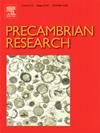Late Ediacaran vendotaenid fossils from North Gondwana margin (Anti-Atlas, Morocco): Spatiotemporal distribution and stratigraphic significance
IF 3.2
2区 地球科学
Q2 GEOSCIENCES, MULTIDISCIPLINARY
引用次数: 0
Abstract
Vendotaenia, a simple ribbon-like fossil, is classified within the informal vendotaenid group alongside morphologically similar fossils. These fossils, which are frequently encountered near the Precambrian-Cambrian boundary, have been hypothesized to possess potential for stratigraphic correlation. However, their taxonomy is often ambiguous and the occurrences in older strata challenge their biostratigraphic significance. In this study, we first report vendotaenid fossils from the Late Ediacaran Tabia Member of the Adoudou Formation in Morocco. Based on meticulous morphological examination of the abundant specimens, these fossils are identified into three distinct morphological taxa, including Vendotaenia, characterized by a constant width and smooth curvature; Tyrasotaenia, also of constant width but commonly folded and twisted; and the lanceolate form Lanceoforma. Furthermore, we have reassessed the related fossil reports within a comprehensive database to evaluate their spatiotemporal distribution. The result shows that all three fossil genera exhibit long temporal ranges with the first appearances predating the Ediacaran. Given their simplistic and often indistinguishable morphology, Vendotaenia and related vendotaenids are deemed unsuitable for stratigraphic correlation of the uppermost Ediacaran.
摩洛哥冈瓦纳北缘晚埃迪卡拉世文多泰类化石:时空分布及其地层意义
Vendotaenia是一种简单的带状化石,与形态相似的化石一起被归类为非正式的Vendotaenia组。这些化石经常在前寒武纪-寒武纪界线附近发现,被认为具有地层对比的潜力。然而,它们的分类往往是模糊的,并且在更古老的地层中出现挑战了它们的生物地层学意义。在本研究中,我们首次报道了来自摩洛哥Adoudou组晚埃迪卡拉世Tabia段的vendotaenid化石。通过对大量标本的细致形态学检查,将这些化石划分为3个不同的形态分类群:Vendotaenia,其特征是宽度恒定,曲率光滑;Tyrasotaenia,也恒定宽度但通常折叠和扭曲;和披针形的刺形。此外,我们在一个综合数据库中重新评估了相关的化石报告,以评估它们的时空分布。结果表明,这三个化石属均具有较长的时间范围,其首次出现时间早于埃迪卡拉纪。考虑到其简单且难以区分的形态,Vendotaenia及其相关的Vendotaenia被认为不适合用于上埃迪卡拉系的地层对比。
本文章由计算机程序翻译,如有差异,请以英文原文为准。
求助全文
约1分钟内获得全文
求助全文
来源期刊

Precambrian Research
地学-地球科学综合
CiteScore
7.20
自引率
28.90%
发文量
325
审稿时长
12 months
期刊介绍:
Precambrian Research publishes studies on all aspects of the early stages of the composition, structure and evolution of the Earth and its planetary neighbours. With a focus on process-oriented and comparative studies, it covers, but is not restricted to, subjects such as:
(1) Chemical, biological, biochemical and cosmochemical evolution; the origin of life; the evolution of the oceans and atmosphere; the early fossil record; palaeobiology;
(2) Geochronology and isotope and elemental geochemistry;
(3) Precambrian mineral deposits;
(4) Geophysical aspects of the early Earth and Precambrian terrains;
(5) Nature, formation and evolution of the Precambrian lithosphere and mantle including magmatic, depositional, metamorphic and tectonic processes.
In addition, the editors particularly welcome integrated process-oriented studies that involve a combination of the above fields and comparative studies that demonstrate the effect of Precambrian evolution on Phanerozoic earth system processes.
Regional and localised studies of Precambrian phenomena are considered appropriate only when the detail and quality allow illustration of a wider process, or when significant gaps in basic knowledge of a particular area can be filled.
 求助内容:
求助内容: 应助结果提醒方式:
应助结果提醒方式:


